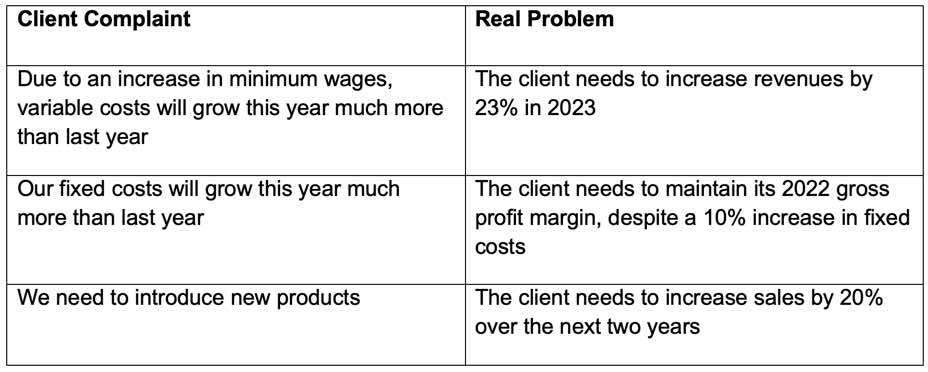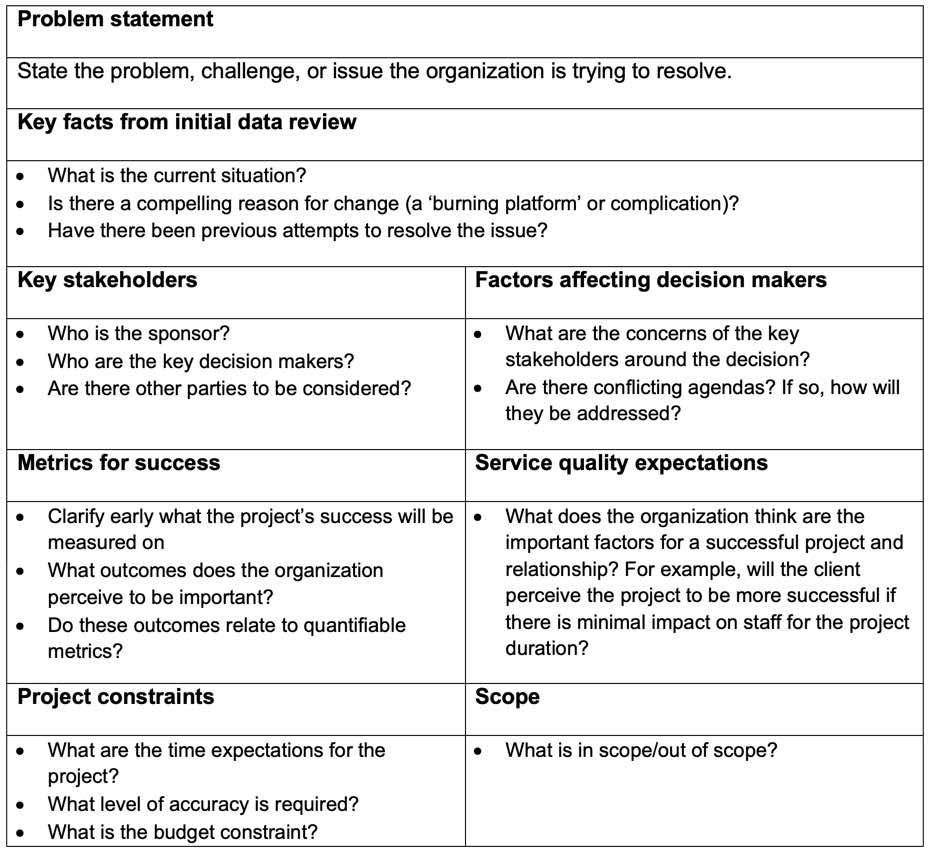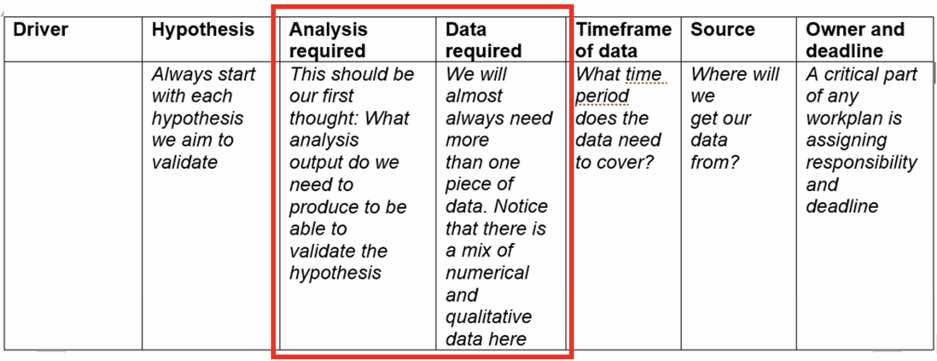The hypothesis-based problem solving (HBPS) approach is a method employed by consultants to develop actionable recommendations for clients using a structured, evidence-based process.
As we saw in the previous article, the HBPS process has five key steps:
- Define the problem
- Define drivers and generate/refine hypotheses
- Determine information needs
- Gather and analyze the data
- Draw conclusions and develop recommendations
In this post, we will explore these five steps in greater detail.
1. Define the problem
Goal: Create a problem statement.
A problem statement is a statement that describes the goals of the client project clearly and concisely. A clear problem statement makes it easier to establish clear boundaries for the project in order to prevent scope creep, ensures that you focus resources and efforts in the right direction, and makes it easier to regularly check back to make sure you are fully addressing the agreed problem. Clients often come to consultants with problems that aren’t well defined. As a result, consultants must make sure that they translate a general complaint into a client problem statement.
A good problem statement should be relevant, action oriented, measurable, and time-bound.
Here are a few examples of what the client might say compared with the real problem.
Notice how each real problem includes a specific target for improvement and a deadline. Without these, you won’t have a clear understanding of the scale of the problem to be solved.
It is worth noting that a problem statement should avoid including symptoms (e.g., Division X productivity is decreasing), methods for solving the problem (e.g., … by benchmarking industry best practices), or proposed solutions (e.g., … by employing more staff).
You must make sure that you agree on the problem statement with the client before proceeding any further. So, to create a robust problem statement you need to involve the client in your thinking to make sure your understanding of the issue aligns with theirs.
Here are some tips that will help you create a robust problem statement:
- Understand who the key stakeholders are and speak to them to understand their views and priorities
- Look at market information and investigate the firm’s previous performance
- Seek to understand the current situation, the compelling reason for change, and previous attempts to resolve the issue
- Understand the factors affecting key decision makers by reviewing concerns and issues and conflicting agendas that may exist
- Ask the client early on ‘What project outcomes would represent success and added value for you?’
- Confirm any project constraints for the client e.g., time, budget
Below is a template that you can use to gather relevant information in order to develop a robust problem statement. You can also download a word version of the template here.
2. Define drivers and generate / refine hypotheses
Goal: Identify the main drivers of the problem and identify possible solutions for each driver.
2.1 Define key drivers
The consultants will need to identify and prioritize the main drivers of the problem by breaking the problem statement down into smaller chunks. Drivers are things that impact the problem you are trying to solve and can be formulated in four different ways:
- Engaging in a group exercise (e.g., mind mapping)
- Adopting different lenses to look at the problem (e.g., a business analysis model such as Porter’s 5 forces / 4 Ps / value chain analysis)
- Brainstorming (i.e., ‘blue sky’ thinking)
- Drawing on past experience (i.e., knowledge of the client’s organization and sector based on previous experience with similar clients)
It’s critical these drivers are kept at a manageable number (around 3 to 5) by clustering them into broader themes. Only include drivers that have high potential value, are worth exploring, and are described in a way that is MECE (i.e., mutually exclusive – don’t overlap each other, and collectively exhaustive – cover all areas relevant to the client).
The drivers need to be broken down into sub-drivers until you can directly define hypothetical answers to the driver question. Identify the relationship between the drivers and order them accordingly. This will help you plan your work, generate hypotheses, and structure your recommendations.
2.2 Generate / refine hypotheses
A hypothesis is a possible solution to a problem that you can test with data and analysis to validate – prove or disprove. Creating good hypotheses is a vital stage in this process, because the wording of the hypotheses will direct the type and amount of data gathering and the analysis that you will subsequently undertake.
In general, a good action-oriented hypothesis should be phrased in the form: “if you do this, you get that”.
To be able to validate a hypothesis, it should have the following five components:
- The action
- The expected business impact of the action
- Who it will impact
- How much impact
- After how long
The four golden rules for a hypothesis are that it should be:
- Testable
- Measurable
- Actionable
- Realistic
Generating hypotheses for possible solutions in a structured way usually involves the following steps:
- Break the problem statement into smaller chunks or drivers
- Cluster the drivers into 3-5 themes
- Make sure the drivers are described in a way that is ‘MECE’
- Arrange drivers in a logical sequence
- Develop hypotheses that answer the driver question
- Trim the hypothesis diagram in order to prioritize
After you have a list of the ostensible drivers of the problem, hypothesize solutions for each driver and prioritize them based on impact and ease of implementation.
Lastly, trim the diagram to ensure a manageable workload. That is, remove any low value hypotheses, consider cost and risk. Normally, a 2×2 effort-impact matrix can help you prioritize.
The end result of this process should be a manageable group of high impact hypotheses that you can prove or disprove with data and analysis.
Below is a summary of a good hypothesis diagram:
3. Determine information needs
Goal: Build a work plan for the data that you need to collect.
After you have produced a list of testable hypotheses about possible answers to the client problem statement, your next step is to create a workplan. A workplan’s purpose is to help you gather the right amount of data to prove or disprove the hypotheses you have developed.
A workplan has three key benefits:
- Keeps your work closely linked to the problem statement
- Provides a big picture of all your work modules that is easy to share with your team and the client
- Ensures focused and efficient data gathering
To begin with, work out what analysis – or end product – you need to produce in order to validate the hypotheses. This will then allow you to determine what data you will need to gather. Make the workplan details specific and complete, which will help when you start gathering the data. Collaborate with the client to help identify the right types of data for them and how to gather it most efficiently.
Other top tips include:
- Make sure you are gathering just enough data, and no more, to be able to validate the hypothesis
- Prioritize work according to the value to the client, availability of the data, and time to gather and analyze
- Review and revise the workplan as needed, as you gain new insights. Keep looking at the ‘big picture’
- Use the workplan to continue to build up the storyboard for your recommendations
Remember the end product for this step is a piece of analysis that can test the hypotheses.
Traps to avoid:
- Don’t focus exclusively on quantitative data. Qualitative data is just as important, especially to compare with the quantitative data. Aim for the right balance
- Don’t define an ‘analysis required’ in a way that is not sufficient to prove or disprove the hypothesis. For example, if your hypothesis is “Eliminating duplication will save $1M in 12 months”, then your analysis required should not be something vague and generic like “Process analysis”.
- Don’t make the end product an outcome instead of a deliverable. e.g., ‘20% cost savings vs. gap analysis of administration costs’
- Don’t create the workplan just based on data that is easily available. Focus on what you need to be able to validate the hypothesis
Below is a good template, with illustrative inputs, of a well-structured workplan to help you organize and plan the analysis and data required to validate your hypotheses. You can also download a word version of the template here.
4. Gather and analyze data
Goal: Analyze the data, and develop insight from the analysis in order to be able to prove or disprove each hypothesis
In Step 3 of the hypothesis-based problem solving process ‘determine information needs’, you identify the data required to prove or disprove each hypothesis. In Step 4, the aim is to collect the data set out in the workplan and analyze it to produce the required output.
You will need to apply a broad range of skills to collect data effectively, such as:
- Cleaning, manipulating, and simplifying numerical data
- Questioning and listening skills when gathering facts and views from people
- Managing biases about what you want to prove or disprove
Once you have gathered the necessary data, you will then need to perform appropriate data analysis, such as:
- Exploring data sets to identify patterns and relationships
- Comparing qualitative and quantitative data to validate conclusions or identify contradictions
- Modelling different scenarios based on the data
- Determining whether the data proves or disproves the hypothesis
- Determining if the data suggests that the hypothesis needs changing
- Determining if more data is needed
Each part of the analysis should do something useful and be linked to the overall value or benefit delivered to the client. As you analyze the data, keep the following tips in mind:
- Keep revising the hypothesis diagram and workplan. Does your work support the aim of validating the hypothesis?
- Be as ready to disprove a hypothesis as you are to prove it
- If your data proves the hypothesis, you can move on to exploring the course of action
- If your analysis disproves the hypothesis, you’ll need to revisit and restructure it and possibly carry out more analysis
- Keep evolving the storyboard for your recommendations report as you gain new insights
5. Draw conclusions and develop recommendations
Goal: Consolidate your findings to answer the client’s ‘So, what?’ question. Interpret your results to come up with insights and clear recommendations.
You have collected the data and analyzed it. You have probably proved or disproved some hypotheses and identified some interesting facts that weren’t known before. Should you just present the results of the analysis to the client?
Remember, consultants bring value to clients through insights, conclusions, and recommendations. Think commercially about the results of the analysis by asking yourself the ‘So what?’ questions. What does this mean for the organization? What will create the most value for them?
Below are some important things to remember about drawing conclusions and developing recommendations:
- Clients pay for the insights and ideas that consultants provide, not just for data analysis
- Drawing conclusions and developing recommendations requires a mix of drawing logical conclusions from the analysis and creative thinking
- You need to put your analysis together into a powerful and coherent story. You don’t merely want the client to understand the recommendations, you need to excite them to want to take action
- Make sure you get the right people involved. Test your conclusions with subject matter experts or other client stakeholders who can give you an independent view and perhaps spark new ideas. Don’t be afraid of having your conclusions questioned
- As you generate insight, keep going back to the storyboard for your report, update it, sense-check it, and see if your story still has any gaps
- The insights you generate may cause you to go back and review your hypotheses and even the problem statement if you no longer think these are correct. This is part of the iterative nature of HBPS
Typically, you will communicate your recommendations through a report or presentation to the client. How you do this is just as important as the recommendations themselves. You can come up with valuable insights and actionable recommendations for your client, but if you don’t communicate them clearly and effectively, you will not achieve the impact that you are being paid to provide.
Skills that will help you draw conclusions and develop recommendations include:
- Critical thinking skills to challenge your thinking
- Creative thinking skills to come up with more insights
- Looking at the ‘bigger picture’ e.g., How will your recommendations affect other parts of the organization? How realistic are your recommendations?
- Appraising different recommendation options to decide which is of the most value to the client
- Structuring the arguments to support your recommendations
- Powerful writing skills
The bottom line
The hypothesis-based problem solving approach is how a strategy consulting engagement is generally structured and executed. It is an iterative approach. It will usually take several cycles of the HBPS process to arrive at the final answer. Be just as ready to disprove a hypothesis as to prove it. If the hypothesis is disproved, then go back and develop new hypotheses.
Jason Oh is a Senior Associate at Strategy&. Previously, he was part of the Global Wealth & Asset Management Strategy team of a large financial institution and served EY and Novantas in their strategy consulting business with industry focus in the financial services sector.
Image: Pexels





